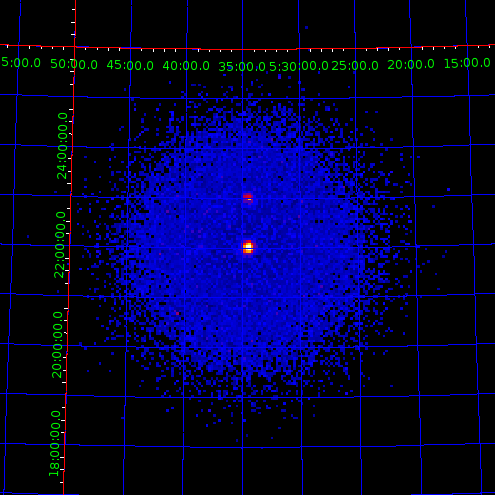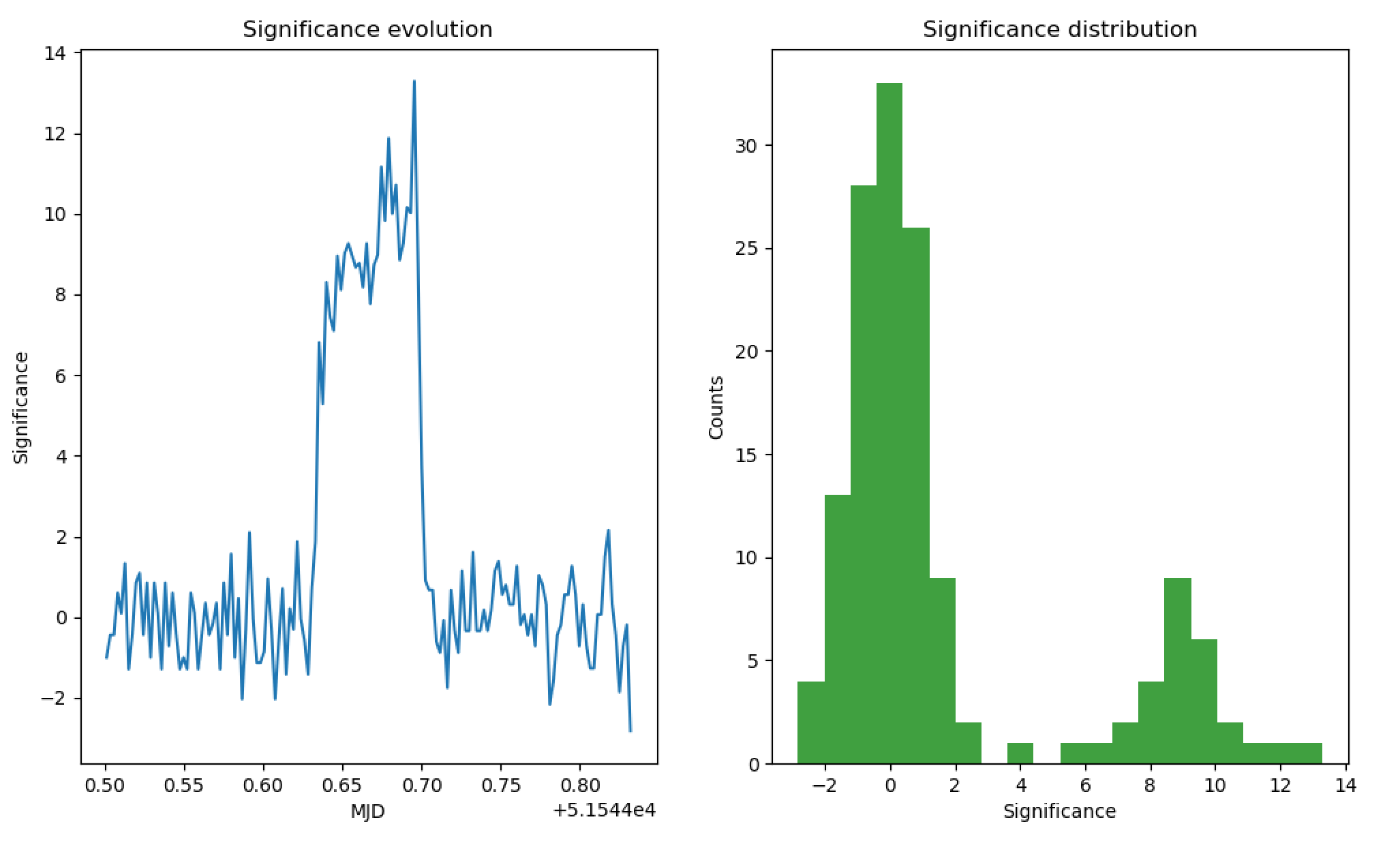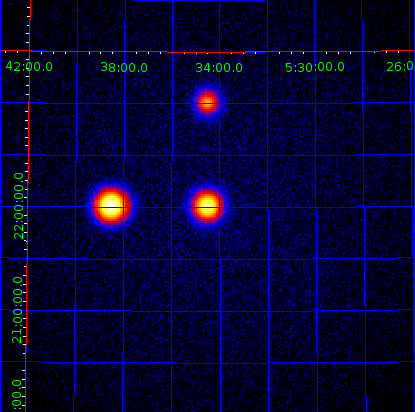Feature #2713
implementation of a time-variability search tool
| Status: | Closed | Start date: | 11/05/2018 | |
|---|---|---|---|---|
| Priority: | Normal | Due date: | 11/11/2018 | |
| Assigned To: | % Done: | 100% | ||
| Category: | - | |||
| Target version: | 1.6.0 | |||
| Duration: | 7 |
Description
Implementation of a new tool to search for time variability.
The tool is intended to be used to search for variability over an event list.
The energy range and the time scale can be directly set by the user.
The tool is based on the algorithms used in HEGS and FAVA.
See here for more details:
https://cta-redmine.irap.omp.eu/attachments/download/2963/variability_presentation.pdf
Recurrence
No recurrence.
History
#1
 Updated by Bonnefoy Simon over 6 years ago
Updated by Bonnefoy Simon over 6 years ago
- File skymap_three_sources.png added
- File skymap_variability.png added
- File variability_evolution.png added
The ctfindvar tool has been implemented.
The tool searches for variability over a given field of view.
The user can provide some observation files or an event list.
The position of several sources can be specified in an xml file, or
only one source coordinate can be set as parameter.
In order to search for variability, the tool bins the events in time
for each pixel, and compares the number of events in each bin with respect
to the others bins, set as background.
Only bins with a significance lower than 4.5, with respect to the background sample,
are kept for the estimation of the background.
This significance threshold is a parameter of the tool and can be changed by the user.
The energy boundaries and the time scale can be set by the user as parameters.
The tool produces one FITS file as output containing:
-a skymap with the highest significance for each pixel
-the significance evolution of the source(s)
-the max significance in the field of view for each time bin.
As an example, we simulated three sources:
-two sources with different level of variability
-one source is not variable
Here is the skymap obtained running ctskymap on the input files (count map).
The three sources are visible with different intensities.
Below is the skymap representing the significance of the variability for each pixel
Here, only the two variable sources are detected, at different level,
given the distinct varibality set for the two sources.
For the sources set in a xml file, a list of the significance evolution
is contained in the output file. From this list, a lightcurve can be built
together with the significance distribution (see exmaples/show_variability_evolution.py).
#2
 Updated by Bonnefoy Simon over 6 years ago
Updated by Bonnefoy Simon over 6 years ago
- Status changed from New to Pull request
- % Done changed from 0 to 100
The final tool can be found here:
Pull repo: simonbonnefoy/ctools
Pull branch: 2713-variability-tool
#3
 Updated by Knödlseder Jürgen about 6 years ago
Updated by Knödlseder Jürgen about 6 years ago
- Status changed from Pull request to Feedback
- Target version set to 1.6.0
I merged the code into the devel branch.
- I changed
ctfindvar::init_cubetoctfindvar::create_cubethat also includes the filling of the cube and the optional smoothing - I added
ctfindvar::analyse_cubethat contains the analysis code that previously was in thectfindvar::runmethod - I added
ctfindvar::get_pixelsthat returns a vector of sky map pixel indices - I added
ctfindvar::sky_modelthat builds a sky model for a given sky direction - I changed the interface to
ctfindvar::get_variability_sigthat now returns the results in aGNdarray - I changed
ctfindvar::fill_alpha_vectortoctfindvar::get_alphasthat now returns a vector of alpha values - I added
ctfindvar::get_tstartandctfindvar::get_tstopmethods to determine start and stop time - I merged
ctfindvar::write_srchistandctfindvar::write_srchist_fitsinto a singlectfindvar::write_source_histogramsmethod. The format of the binary table extensions was also changed, since it was not very clear what the content of the second position extension was. Now, the third extension contains three columns, a first with a source name, and two others with Right Ascension and Declination. One could image to store alsoTSTARTandTSTOPin seconds, and to have the time reference saved in the header file, which would make the extension more OGIP compliant.
/***********************************************************************//**
* @class ctfindvar
*
* @brief Time variability search tool
*
* @todo Add tool description.
***************************************************************************/
class ctfindvar : public ctobservation {
public:
// Constructors and destructors
ctfindvar(void);
explicit ctfindvar(const GObservations& obs);
ctfindvar(int argc, char *argv[]);
ctfindvar(const ctfindvar& app);
virtual ~ctfindvar(void);
// Operators
ctfindvar& operator=(const ctfindvar& app);
// Methods
void clear(void);
void run(void);
void save(void);
// Get the information on the time interval from
int time2inx(const GTime& time);
GGti inx2gti(const int& indx);
const GSkyMap& counts(void);
protected:
// Protected methods
void init_members(void);
void copy_members(const ctfindvar& app);
void free_members(void);
void get_parameters(void);
void init_gtis(void);
void create_cube(void);
void fill_cube(GCTAObservation* obs);
void analyse_cube(void);
std::vector<int> get_pixels(void);
GNdarray get_variability_sig(const int& ipix);
std::vector<double> get_alphas(const int& ipix) const;
double gti_overlap(const GGti& gti1, const GGti& gti2) const;
GTime get_tstart(void);
GTime get_tstop(void);
GModelSky sky_model(const GSkyDir& dir) const;
void write_source_histograms(GFits& fits);
// Protected members
GSkyMap m_counts; //!< Counts for each time interval
std::vector<GGti> m_gti; //!< List of time intervals
GModels m_inmodel; //!< List of models for source positions
GSkyDir m_max_sig_dir; //!< Sky direction associated with maximum significance
double m_minoff; //!< Minimum counts for use in significance calculation
double m_sig_threshold; //!< Minimum significance required to set source as variable
GSkyMap m_peaksigmap; //!< Skymap holding the maximum significance
GNdarray m_pixsigsrc; //!< Store distributions of the source significances
GNdarray m_pixsigmax; //!< Store distribution for pixel with max significance
GTime m_tstart; //!< Start time for variability study
GTime m_tstop; //!< Stop time for variability study
GEnergy m_emin; //!< Minimum energy for events
GEnergy m_emax; //!< Maximum energy for events
GModels m_model_above_thr; //!< Model storing position with significance above thr
};
Furthermore, I changed some of the parameter names for compliance with the other ctools. Specifically:
- I removed the
prefixparameter and replaced it by the explicit filename parametersoutmapandoutmodel - I renamed
sig_thrtothreshold - I renamed
smoothkrnltosmooth_kernel - I renamed
smoothpartosmooth_rad
I addition, the emin and emax parameters can no longer be zero, since the energy limits are needed in the alpha computation. This should be changed in the future so that general background models can be supported, and not only the IRF background model. I created a new feature for that: #2769.
# # General parameters #=================== inobs, f, a, events.fits,,, "Input event list or observation definition XML file" inmodel, f, h, NONE,,, "Input model definition file for extracting source positions" outcube, f, h, NONE,,, "Output counts cube file" outmap, f, a, map.fits,,, "Output map file" outmodel, f, a, model.xml,,, "Output model definition file" caldb, s, a, prod2,,, "Calibration database" irf, s, a, South_0.5h,,, "Instrument response function" # # Variability search parameters #============================== coordsys, s, a, CEL,CEL|GAL,,"Coordinate system (CEL - celestial, GAL - galactic)" xsrc, r, a, 83.63,0,360, "First coordinate of the source of interest (RA or galactic l)" ysrc, r, a, 22.01,-90,90, "Second coordinate of the source of interest (DEC or galactic b)" emin, r, a, 0.1,,, "Lower energy limit (TeV)" emax, r, a, 100.0,,, "Upper energy limit (TeV)" threshold, r, h, 4.5,,, "Significance threshold for variability detection" minoff, r, h, 0,,, "Minimum required events in off bin for computing Noff and alpha" smooth_kernel, s, h, NONE, GAUSSIAN|DISK|NONE,, "Smoothing kernel for counts maps" smooth_rad, r, h, 0.05,,, "Smoothing kernel radius (deg)" # # Time binning parameters #=========================== tinterval, r, a, 300,,, "Time interval for each bin (seconds)" tmin, t, a, NONE,,, "Start time (UTC string, JD, MJD or MET in seconds)" tmax, t, a, NONE,,, "Stop time (UTC string, JD, MJD or MET in seconds)" # # Spatial binning parameters #=========================== usepnt, b, h, no,,, "Use pointing instead of xref/yref parameters?" nxpix, i, a, 200,,, "Size of the X axis in pixels" nypix, i, a, 200,,, "Size of the Y axis in pixels" binsz, r, a, 0.02,,, "Image scale (in degrees/pixel)" proj, s, a, CAR,AIT|AZP|CAR|GLS|MER|MOL|SFL|SIN|STG|TAN,, "Projection method" xref, r, a, 83.63,0,360, "First coordinate of image center in degrees (RA or galactic l)" yref, r, a, 22.51,-90,90, "Second coordinate of image center in degrees (DEC or galactic b)" # # Standard parameters #==================== nthreads, i, h, 0,0,1000, "Number of parallel processes (0=use all available CPUs)" chatter, i, h, 2,0,4, "Chattiness of output" clobber, b, h, yes,,, "Overwrite existing output files with new output files?" debug, b, h, no,,, "Activate debugging mode?" mode, s, h, ql,,, "Mode of automatic parameters" logfile, f, h, ctfindvar.log,,, "Log filename"
From my side things look okay. Could you please double check that the code is also okay from your side.
#4
 Updated by Knödlseder Jürgen almost 6 years ago
Updated by Knödlseder Jürgen almost 6 years ago
- Status changed from Feedback to Closed
Code was merged into devel.


